Preposition"A preposition is a term or phrase preceding the nouns, pronouns, or noun phrases to indicate directions, timing, place, location, spatial relations, or introducing an item." Terms like "in," "at," "on," "of," and "to" are instances of prepositions. 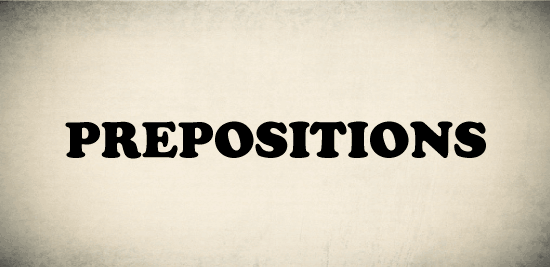
Moreover, it is important to note that in English language, prepositions are extremely idiomatic. While there are some useful guidelines, many prepositions are controlled by fixed expressions. In these circumstances, remember the phrase rather than the individual preposition. What Is a Preposition?"Ghosts! Monsters! Ghouls!" "Where?!" "Beside You" Prepositions are a godsend. Consider not understanding where the threat was... Prepositions indicate where or when something is in relationship to another. When demons approach, it's useful to have these unique words to notify us where they are. Are they next to them or adjacent/in front of them? Will they show up in one second or at nightfall? 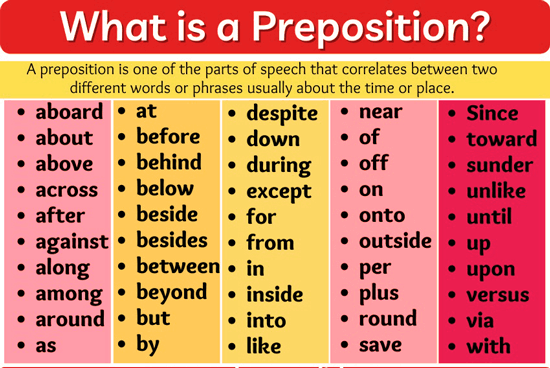
Prepositions frequently indicate where one noun is in relationship with another (e.g., The orange juice is on the desk beside you). However, they can also represent more abstract concepts such as goal or contrast (e.g., They went for exercising despite the rain). A preposition occurs prior to its complement, while a postposition follows after it. However, there are some exceptions, like as "ago" and "notwithstanding," as in "four days ago" and "budget limitations notwithstanding," English Grammar or the language typically utilizes prepositions instead of postpositions - terms such as in, under, and of precede their items, such as in Britain, under the desk, of Anna and so on. 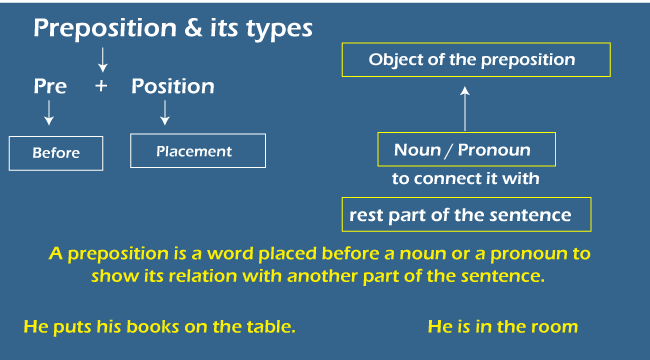
Preposition (pre + placement) implies "position or place it before." "A preposition is frequently placed BEFORE another term, most often a noun phrase." It describes the relationship between the noun phrase and another component of the statement. A few common preposition include: in, of, on, for, with, at, and by. 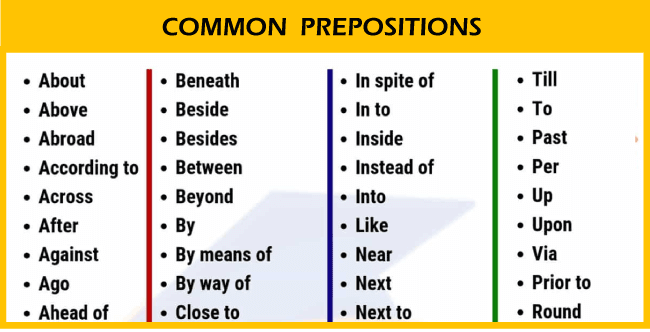
Consider the following sentences:
Prepositions are also used to express a variety of different relationships. Furthermore, more figurative meanings, such as "in romance," "beyond question," and "under inquiry," can be represented. Even if a preposition does not appear BEFORE another term, it is strongly related to some other word:
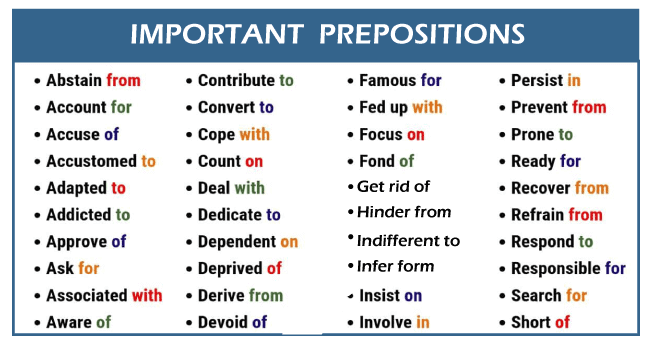
FormPrepositions do not have a specific form. Prepositions are mostly single words, while some are two- or three-word words:
When we say a preposition occurs prior to the noun phrase, we mean the following:
A Few Principles of the Preposition1. Preposition of DirectionUtilize the prepositions like "to," "on," "into," "in," and "onto" to indicate the direction.
2. Time PrepositionsEmploy the prepositions like "in," "at," and "on" to indicate a certain time. Also employ the preposition "in" to indicate certain periods of the day, month, year, and season.
When referring to the time of day, utilize "at." Employ "at" with noon, night, and midnight as well.
Employ on with the days
To allude to a period of time that has passed, employ the preposition like "since," "for," "by," "during," "from to," "from until," "with," and "inside."
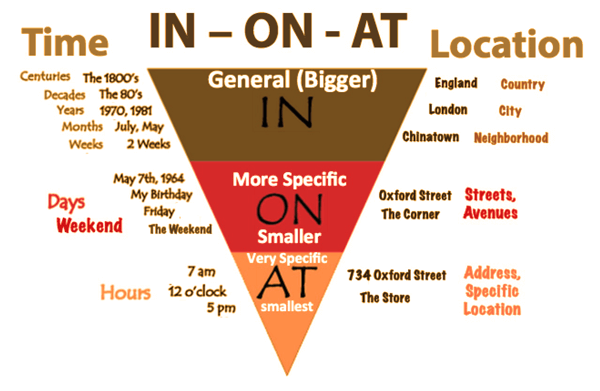
3. Prepositions of PlaceUtilize the preposition "in" (the place itself), "at" (the general neighborhood), "on" (the area), and "within" (something contained) to describe a location.
Utilize the prepositions "over" and "above" to refer to objects above or higher than a position. Employ the prepositions "below," "beneath," "under," and "underneath" to describe objects below a position.
Employ the preposition like "by," "near," "next to," "between," "among," and "against" to describe an item near the mark.
4. Location-based PrepositionsEmploy the prepositions "in" (a defined area or volume), "at" (a location), and "on" to refer to a location (a surface).
5. Spatial Relationship PrepositionsEmploy the preposition like "above," "across," "against," "ahead of," "along," "among," "around," "behind," "below," "beneath," "beside," "between," "from," "in front of," "within," "near," "off," "out of," "through," "toward," "under," and "inside" to allude to a spatial relationship.
Utilizing PrepositionsPrepositions are terms that indicate a relationship. Without the usage of a preposition, a statement would be meaningless. There are various types of prepositions utilized in the English language that not only provide detail but also finish a sentence. "Prepositions are utilized to convey information such as place, timing, directions, cause, and possession." Using Preposition (s) at the Ending of the SentenceOnce upon a time, children were instructed that a phrase must never end with a preposition. This rule is linked with Latin grammar, whereas many features of Latin grammar have found their way into English; following this particular grammatical rule might result in confused or difficult sentence patterns. Since the goal of writing is to explain your ideas effectively, it is okay to conclude a sentence with a preposition if the alternatives would cause misunderstanding or is too formal. For instance, The truck had not been charged for. (This sentence ends with a preposition, which is allowed.) Unclear Revision: Charged for the truck had not been. (This sentence is confusing and unclear) Example: I want to understand where Helen comes from. (This sentence concludes with a preposition, which is allowed.) Overly Grammatical Revision: I want to understand from where Helen comes. (Grammarly correct, but unnecessarily formal.) Nobody genuinely speaks in this manner.) In academic work, although, you might choose to revise the statements to prevent concluding with a preposition. As this also helps in maintaining a more formal style. Example: My study will focus on the society the educators resided in. Revision: My study will focus on the society in which the educators resided 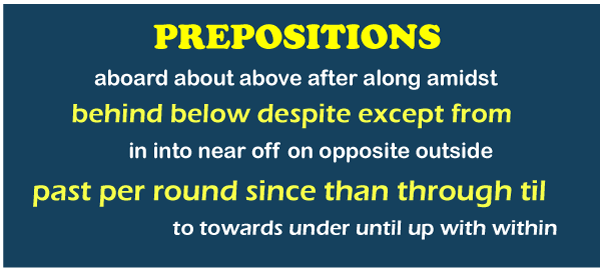
Prepositions that come after verbs and adjectivesA preposition precedes certain verbs and adjectives. When distinct prepositions accompany verbs and adjectives, the sentence takes on various meanings. Few Common Verb-Preposition Combos are; About: worry, complain, read At: arrive(at an event etc.), smile, look From: differ, suffer In: occur, result, etc While verb + preposition combinations resemble phrasal verbs, the verb and particle (in this instance, the preposition) in such combos cannot be distinguished as phrasal verbs can. Wordiness and Prepositional PhrasesSo many prepositional expressions, like several pronouns, can cause wordiness in a statement: For instance, "The writer used a mixed-method approach to describe that the goal of the study was to investigate the managerial skills of school administrators as a way of gauging teacher contentment in the first year of education." This type of statement could be trimmed and simplified to reduce the number of prepositional phrases and clarify the writer's intention: Revision: "The writer used a mixed-method approach to investigate the managerial skills of administrators and their effect on first-year teacher efficacy." Prepositions That Aren't NecessaryRemove the preposition if it is unneeded. This results in clearer and more clear writing. Example: Where are the sheets at? Revision: Where are the sheets? Example: She leaped off of the balancing board. Revision: She leaped off the balancing board. Thus, the removal of prepositions pushes you to tighten up the statement. As a result, sentences are shorter, more straightforward, and easier to grasp.
Next TopicPreposition List
|
 For Videos Join Our Youtube Channel: Join Now
For Videos Join Our Youtube Channel: Join Now
Feedback
- Send your Feedback to [email protected]
Help Others, Please Share










